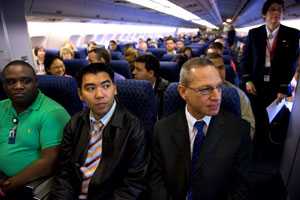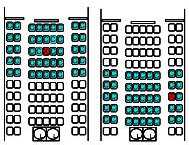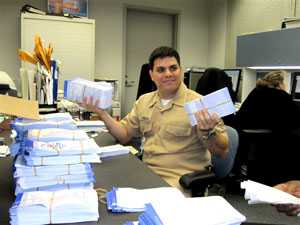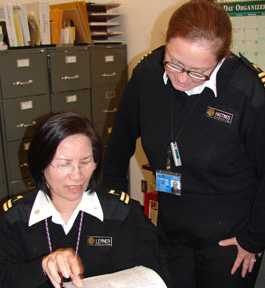Protecting Travelers' Health from Airport to Community: Investigating Contagious Diseases on Flights
What if a passenger was ill on your flight? What if that person was later diagnosed with a serious infectious disease and was contagious during your flight? Are you at risk? Would you want to know if you had been exposed and how to protect yourself?

Passengers and flight attendant. Photo credit: Greg Knobloch, CDC
Although the risk of getting a contagious disease on an airplane is low, public health officers sometimes need to find and alert travelers who may have been exposed to an ill passenger. Contact investigation is one of the ways the Centers for Disease Control and Prevention (CDC) works with partners in the United States and other countries to protect the health of people exposed to an illness.
Through contact investigations on airplanes, CDC also seeks to protect the health of communities from contagious diseases that are just a flight away.
Answering the Call
A contact investigation often starts with a call… The phone rings at a CDC Quarantine Station located at a U.S. international airport. The caller is a public health officer at a county health department. This officer informs the CDC quarantine public health officer that a recent air traveler was diagnosed with a specific contagious disease. This ill traveler is now referred to as the “index case.”
The county health officer calls the CDC Quarantine Station because other passengers on the plane may have been exposed, and they need to be notified. The passengers exposed to the index case are called “contacts.”
CDC Quarantine Stations are responsible for coordinating contact investigations of illness exposures on arriving international flights or flights between States.
A person can be contagious without showing any symptoms while the disease is developing (incubating) in the body. Quarantine public health officers must determine whether the index case was contagious during a flight. Their decision is based on the disease, history of symptoms, and the date of the flight.

A CDC quarantine public health officer takes a call from the local health department. Photo credit: Greg Knobloch, CDC
Starting the Contact Investigation
If the index case was contagious during the flight, passengers seated nearby may have been exposed to the disease. The CDC Quarantine Station will start a contact investigation.
CDC first calls the airline to confirm where the index case sat. Then CDC requests the flight manifest for passengers seated near the index case. The flight manifest is a document that contains passengers’ names, seat numbers, and contact information. CDC guards the privacy of passengers by keeping this information secure.
Consider the contact information you gave to the airlines when you booked your flight. If you’re in a frequent flyer program, is your contact information correct?
Diseases of Concern During Air Travel

Seating diagram for passengers exposed to measles, rubella, or TB. The red seat indicates the index case.
Most flight contact investigations are performed for infectious tuberculosis (TB), measles, rubella (German measles), pertussis (whooping cough), and meningococcal disease (meningitis).
CDC has developed instructions (protocols) for investigating different diseases. CDC uses these protocols to identify passengers who may have been exposed during a flight. Identifying contacts is based on the disease, how it spreads, and where a passenger was seated in relation to the index case.
An example is shown here of the seating chart used for TB, measles, and rubella contact investigations. Shown in blue-green are the exposed passengers who will be notified. They sat on the same row, two rows in front of, and two rows behind the index case (shown in red).
There are two exceptions to the seating chart shown. Two types of passengers will be considered contacts regardless of where they sat:
- All traveling companions of the index case who were on the same flight
- For measles and rubella, all babies (aged 2 years or younger) sitting on the lap of an adult. These babies may be too young to have been vaccinated and would be at high risk for getting the disease.
For pertussis and meningococcal disease, only passengers seated next to the index case are considered exposed.
Did you provide accurate information?
Contact information from the flight manifest is often incomplete.

A CDC quarantine public health officer reviews U.S. Customs Declaration forms for passengers' contact information.
CDC relies on U.S. Customs and Border Protection (CBP) for help with contact investigations involving international flights. CBP can often provide more information that fills in the gaps, such as from U.S. Customs Declaration forms. These forms are completed by each family when entering the United States.
Think about when you filled out your U.S. Customs Declaration form when arriving on an international flight. How accurate and complete was it, and how legible?
The ability to contact you is only as good as the information you provide! How will you know if you were exposed if no one can reach you?
CDC staff review the Customs Declaration forms. They then combine the information obtained from CBP and the airline’s flight manifest to get the best possible information for locating exposed passengers. At every step, CDC protects the privacy of this information.
Protecting the Health of Passengers
CDC provides the exposed passengers' contact information to state and local health departments or ministries of health in the countries where the passengers live. These agencies then try to locate these passengers and inform them about their exposure and what to do.
Exposed passengers (contacts) may be asked whether they are protected against (immune to) the specific disease. They can be immune if they had the disease in the past or have received a vaccine.
Public health officers will educate contacts about how to watch for and report symptoms of the illness being investigated. Contacts who aren't immune (for example, because they haven't been vaccinated for the illness) may need to receive preventive drugs or a vaccine to protect them from the disease. Any recommendations will be based on the disease, availability of preventive drugs or vaccines, and the amount of time passed since exposure.
Privacy Protection
CDC does not release any information about the index case or the contacts to anyone other than public health staff working on the investigation.
This information is protected, and access is strictly limited to public health use.
This process is how federal agencies and the airlines work together to help state and local health departments find exposed passengers. If you are considered a contact of an index case on an airplane, they will call you. But first, make sure you leave a number where they can reach you.
- Page last reviewed: June 22, 2012
- Page last updated: March 10, 2014
- Content source:


 ShareCompartir
ShareCompartir
